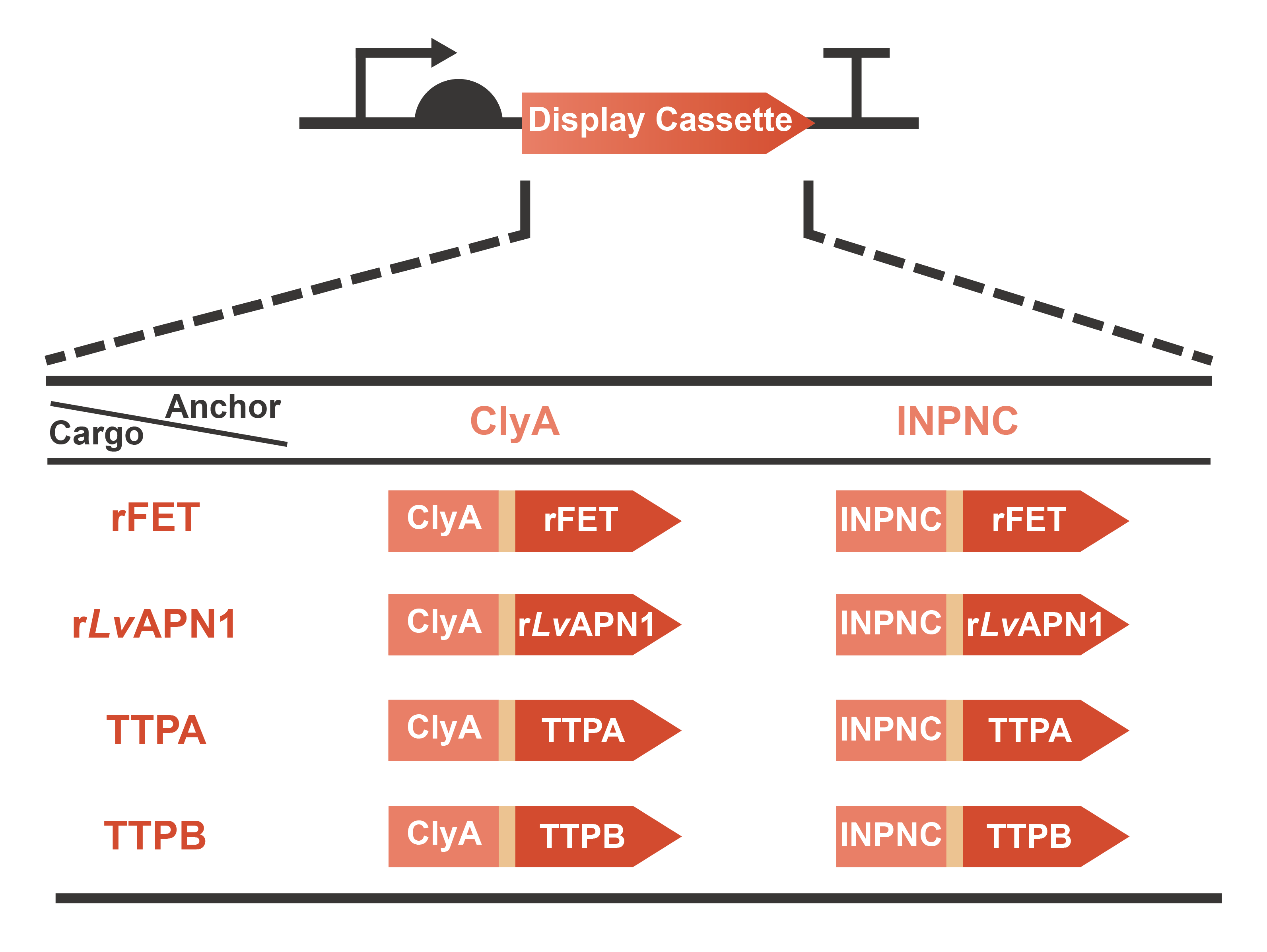Difference between revisions of "Part:BBa K4195029"
| Line 2: | Line 2: | ||
__NOTOC__ | __NOTOC__ | ||
<partinfo>BBa_K4195029 short</partinfo> | <partinfo>BBa_K4195029 short</partinfo> | ||
| + | ===Biology=== | ||
| + | ClyA | ||
| − | + | Cytolysin A (ClyA) is a pore-forming toxin that is produced by some bacteria from the ''Enterobacteriaceae'' family. When fused to the C-terminal of ClyA, heterologous proteins can be displayed on the surface of the engineered bacteria and OMVs (outer membrane vesicles) released by them (''1''). | |
| + | |||
| + | r''Lv''APN1 | ||
| + | |||
| + | ''Lv''APN1, a protein from the aminopeptidase N family, was identified in ''Litopenaeus vannamei'' hemocytes as a receptor for VP<sub>AHPND</sub> toxin PirA and PirB, which can help the toxins pass through the cell membrane of hemocytes (''2''). | ||
| + | |||
| + | r''Lv''APN1 is a truncated form of ''Lv''APN1 (residues 205-591) that composes of a crystal insecticidal (Cry) toxin binding region and the active site of peptidase-M1 domain, which was reported to directly bind to both PirA and PirB toxins (''2''). What’s more, there is no glycosylation site in r''Lv''APN1, which makes it easier to obtain the purified protein by using prokaryotic expression system (such as ''E. coli''). | ||
| + | ===Usage and design=== | ||
| + | Engineering OMVs for treating and preventing AHPND caused by the pathogen ''V. parahaemolyticus'' are a significant part of '''OMEGA''' project (<u>O</u>perable <u>M</u>agic to <u>E</u>fficiently <u>G</u>etting over <u>A</u>HPND). Based on the efforts of our previous projects in 2020 ([https://2020.igem.org/Team:XMU-China AnTea-Glyphosate]) and 2021 ([https://2021.igem.org/Team:XMU-China SALAGE]), we further developed the '''surface display system''' on the OMVs released by the engineered bacteria. The usage of cargo proteins was no more limited to enzymes that are usually utilized to catalyze series bio-chemical reactions, since some receptors or ligands involved in complex '''protein-protein interaction''' (PPI) were selected as the cargo candidates. This year, we chose two classic anchor proteins, ClyA and INPNC, to construct the display cassette with various cargo proteins including rFET (receptor), r''Lv''APN1 (receptor), TTPA (ligand) and TTPB (ligand) (Fig. 1). On one hand, with the receptors displayed, OMVs will gain the function of neutralizing toxins secreted by ''V. parahaemolyticus''. On the other hand, with the assistance of ligands displayed on the surface, OMVs will become a special vector to deliver antimicrobials for the specific pathogen. In summary, we have taken a step closer to the collections of '''extracellular functional elements''' ('''EFE'''), '''combining the OMVs''', '''secretion systems and surface display systems''' which we have been dedicated to since 2020. Learn more information from our [https://2022.igem.wiki/xmu-china/design Design] page. | ||
| + | |||
| + | [[File:T--XMU-China--surface display circuit.png|300px]] | ||
| + | |||
| + | '''Fig. 1 Graphic description of the expression gene circuits for display cassette designed in OMEGA project.''' | ||
| − | |||
| − | |||
<!-- --> | <!-- --> | ||
Revision as of 18:26, 10 October 2022
clyA-rLvAPN1
Biology
ClyA
Cytolysin A (ClyA) is a pore-forming toxin that is produced by some bacteria from the Enterobacteriaceae family. When fused to the C-terminal of ClyA, heterologous proteins can be displayed on the surface of the engineered bacteria and OMVs (outer membrane vesicles) released by them (1).
rLvAPN1
LvAPN1, a protein from the aminopeptidase N family, was identified in Litopenaeus vannamei hemocytes as a receptor for VPAHPND toxin PirA and PirB, which can help the toxins pass through the cell membrane of hemocytes (2).
rLvAPN1 is a truncated form of LvAPN1 (residues 205-591) that composes of a crystal insecticidal (Cry) toxin binding region and the active site of peptidase-M1 domain, which was reported to directly bind to both PirA and PirB toxins (2). What’s more, there is no glycosylation site in rLvAPN1, which makes it easier to obtain the purified protein by using prokaryotic expression system (such as E. coli).
Usage and design
Engineering OMVs for treating and preventing AHPND caused by the pathogen V. parahaemolyticus are a significant part of OMEGA project (Operable Magic to Efficiently Getting over AHPND). Based on the efforts of our previous projects in 2020 (AnTea-Glyphosate) and 2021 (SALAGE), we further developed the surface display system on the OMVs released by the engineered bacteria. The usage of cargo proteins was no more limited to enzymes that are usually utilized to catalyze series bio-chemical reactions, since some receptors or ligands involved in complex protein-protein interaction (PPI) were selected as the cargo candidates. This year, we chose two classic anchor proteins, ClyA and INPNC, to construct the display cassette with various cargo proteins including rFET (receptor), rLvAPN1 (receptor), TTPA (ligand) and TTPB (ligand) (Fig. 1). On one hand, with the receptors displayed, OMVs will gain the function of neutralizing toxins secreted by V. parahaemolyticus. On the other hand, with the assistance of ligands displayed on the surface, OMVs will become a special vector to deliver antimicrobials for the specific pathogen. In summary, we have taken a step closer to the collections of extracellular functional elements (EFE), combining the OMVs, secretion systems and surface display systems which we have been dedicated to since 2020. Learn more information from our Design page.
Fig. 1 Graphic description of the expression gene circuits for display cassette designed in OMEGA project.
Sequence and Features
- 10COMPATIBLE WITH RFC[10]
- 12COMPATIBLE WITH RFC[12]
- 21COMPATIBLE WITH RFC[21]
- 23COMPATIBLE WITH RFC[23]
- 25INCOMPATIBLE WITH RFC[25]Illegal NgoMIV site found at 1773
Illegal AgeI site found at 1714
Illegal AgeI site found at 1821 - 1000INCOMPATIBLE WITH RFC[1000]Illegal SapI.rc site found at 645

